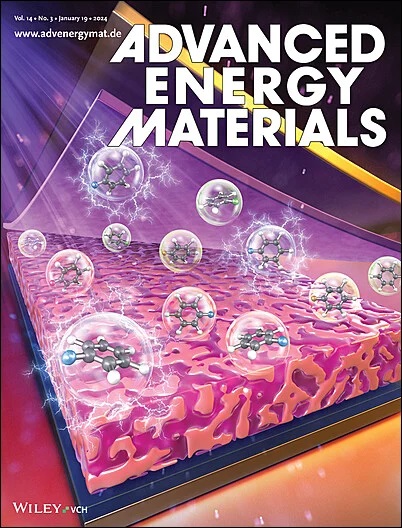Multifunctional Universal Additive for Stable and Efficient Inverted Perovskite Solar Cells
IF 24.4
1区 材料科学
Q1 CHEMISTRY, PHYSICAL
引用次数: 0
Abstract
The performance of perovskite solar cells has significantly improved over the years in part due to defect passivation in the bulk and at the interfaces. While many additive molecules have been reported in the literature, they are commonly applicable only to one particular perovskite composition. Here we investigate a multifunctional additive, 4-amino-5-bromo nicotinic acid (ABrNA), for use in both methylammonium (MA)-free perovskites with different Br content (bandgaps ranging from 1.53 to 1.73 eV) as well as MA-containing perovskites. Significant performance improvements are obtained for all compositions, which can be attributed to the presence of multiple functional groups capable of modifying the crystallization of the perovskite as well as passivating defects. Exceptional features of ABrNA make it a promising universal passivator, which leads to a PCE increase from 23.9% to 25.0% for CsFAMA solar cells, and from 22.0% to 23.0% for MA-free solar cells. The ABrNA passivated MA-free devices also exhibit exceptional operational stability, with T90 exceeding 1000 h under ISOS-L-1 testing conditions. In addition, significant performance improvement is observed with ABrNA for modules in both conventional and inverted device architectures, further confirming the universality of ABrNA additive.

稳定高效倒钙钛矿太阳能电池的多功能通用添加剂
钙钛矿太阳能电池的性能在过去几年里有了显著的提高,部分原因是在本体和界面处的缺陷钝化。虽然文献中报道了许多添加剂分子,但它们通常只适用于一种特定的钙钛矿成分。在这里,我们研究了一种多功能添加剂,4-氨基-5-溴烟酸(ABrNA),用于不同Br含量(带隙从1.53到1.73 eV)的无甲基铵(MA)钙钛矿和含MA的钙钛矿。所有组合物的性能都得到了显著的改善,这可以归因于能够改变钙钛矿结晶以及钝化缺陷的多个官能团的存在。ABrNA的特殊特性使其成为一种很有前途的通用钝化剂,使CsFAMA太阳能电池的PCE从23.9%提高到25.0%,无ma太阳能电池的PCE从22.0%提高到23.0%。ABrNA钝化的无ma器件也表现出出色的操作稳定性,在iso - l -1测试条件下T90超过1000小时。此外,在传统和倒置器件架构中,ABrNA对模块的性能都有显著改善,进一步证实了ABrNA添加剂的通用性。
本文章由计算机程序翻译,如有差异,请以英文原文为准。
求助全文
约1分钟内获得全文
求助全文
来源期刊

Advanced Energy Materials
CHEMISTRY, PHYSICAL-ENERGY & FUELS
CiteScore
41.90
自引率
4.00%
发文量
889
审稿时长
1.4 months
期刊介绍:
Established in 2011, Advanced Energy Materials is an international, interdisciplinary, English-language journal that focuses on materials used in energy harvesting, conversion, and storage. It is regarded as a top-quality journal alongside Advanced Materials, Advanced Functional Materials, and Small.
With a 2022 Impact Factor of 27.8, Advanced Energy Materials is considered a prime source for the best energy-related research. The journal covers a wide range of topics in energy-related research, including organic and inorganic photovoltaics, batteries and supercapacitors, fuel cells, hydrogen generation and storage, thermoelectrics, water splitting and photocatalysis, solar fuels and thermosolar power, magnetocalorics, and piezoelectronics.
The readership of Advanced Energy Materials includes materials scientists, chemists, physicists, and engineers in both academia and industry. The journal is indexed in various databases and collections, such as Advanced Technologies & Aerospace Database, FIZ Karlsruhe, INSPEC (IET), Science Citation Index Expanded, Technology Collection, and Web of Science, among others.
 求助内容:
求助内容: 应助结果提醒方式:
应助结果提醒方式:


